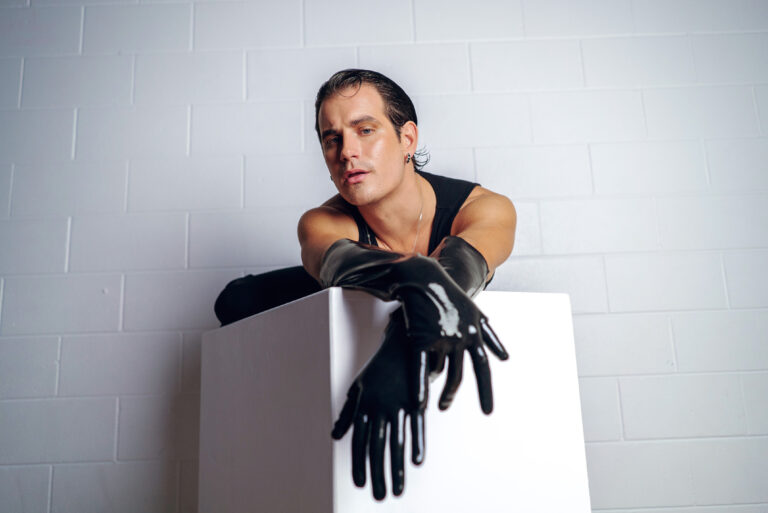Choreographer Lauren Adams has strong ties to Spotlight Dance Works. She began her training there with Liz Schmidt’s mentor.
Megan Lawson is on a mission: finish choreographing the senior piece for Dance Impressions studio in just three days. Typically, she likes to take four days for such a project, but this piece spotlights star senior Mattie Love—alongside 15 other dancers—and Love needs to head out on tour with New York City Dance Alliance within 72 hours. There’s also much at stake: The Utah-based studio travels to NYCDA Nationals as a team only once every four years, and a lot is riding on this piece.
Though Lawson is admittedly stressed out by the time crunch, you wouldn’t know it. The dynamic, quirky guest choreographer, known for her two-time stint on MTV’s “America’s Best Dance Crew” with her crew Fanny Pak, is more than up for the challenge. The work begins right after school on a wintry December day, goes late, resumes at 3 pm the next day and doesn’t stop until 9:30 pm. Clad in a bold flowered onesie and armed with Starbucks, Lawson provides high energy that’s contagious—and much needed considering the task at hand.
“When Megan comes, the kids tap into their colorful side; there’s a great energy, and she really brings out their personalities,” says studio director Kandee Allen.
The process of selecting the other 15 dancers has been relatively simple; this isn’t Lawson’s first visit to Dance Impressions. (Allen and Lawson originally met through a referral from Allen’s sister, who owns The Dance Zone in Las Vegas.) “Generally, most choreographers can figure out who they want really quickly; Megan usually uses a short improv session or four counts of eight,” says Allen. “She can nail what kids have to offer really well.”
Though the to-do list is long, Lawson’s guest residency isn’t all work and no play—amid the master classes and choreography, Allen makes time to take Lawson on a drive into the mountains of Park City, UT, and to get her favorite mango pistachio wild rice pudding at a local deli. And, of course, Lawson can’t leave without signing the signature wall that displays the John Hancocks of all of the prominent choreographers who’ve visited the studio—from Joey Dowling to Travis Wall to Cedar Lake dancer Matthew Rich.
The piece, set to Sade’s “Morning Bird,” debuts just a few months later at NUVO, and it goes on to win “Critics’ Choice” at NYCDA Nationals. “It was really magical and simple,” says Allen. “It was all about flying free—with one bird setting the others free.”
As Dance Impressions’ experience with Lawson demonstrates, bringing in a guest choreographer can be a rewarding growth experience. “Outside choreographers see the kids differently than their regular teachers, so they challenge them in new ways and give them something fresh,” says Allen, who brings in as many as six guest artists every year.
At Chesterfield, Michigan–based Spotlight Dance Works, owner Liz Schmidt has developed ongoing relationships with choreographers such as Lauren Adams (who has visited for the last 15 years), Sonya Tayeh and Brooke Pierotti—and continues to bring in new talent every year as well.
“It gives our students the chance to have a special piece choreographed by someone who is a hero to them,” says Schmidt. “By getting to know them and their work on a more personal level, it makes the kids feel more confident at conventions; plus, it’s a huge growth experience because they’re working on choreography that’s out of their comfort zones.”
But as Allen and Schmidt will tell you, it takes planning and commitment to pull off a successful collaboration. Here’s how they do it.
Planning ahead. Doing ample legwork ahead of time will ensure a smooth experience for both company director and choreographer. Step one typically involves nailing down the logistics—cost, length of stay, what the visit will entail and accommodations/travel. It’s important to provide ample lead time; Allen says she has booked choreographers with anywhere from three days’ to six months’ notice.
Pre-communication is key. For instance, choreographer Lauren Adams says that there have been numerous times where she’s arrived at a studio and realized that the planned schedule won’t work for her needs. “Make sure that the choreographer gets full breaks, and be sure to consult him or her before finalizing the schedule,” she says.
Yet, even with the best planning, be prepared to handle last-minute requests. It comes with the territory, says Allen, who recalls instances where she had to find a pinball machine on wheels for Joey Dowling and a portable grand piano for Travis Wall. “Most choreographers are so busy with shows and jobs that they end up planning last minute,” she says. “We try to get a checklist ahead of time, but that doesn’t always happen.”
Length of stay. At Spotlight Dance Works, Schmidt invites choreographers to stay for a long weekend, starting with master classes on Friday (90 minutes for each of the three age groups: junior, teen and senior), followed by morning classes on Saturday and two days of choreography with the seniors. “Most choreographers feel comfortable with two days—it gives them a good headstart the first day, and then they can come back with fresh eyes and finish up,” she says.
Megan Lawson’s Morningbird won National Senior Critics’ Choice at New York City Dance Alliance in 2012.
Dancer/artist introductions.
Holding master classes can play an important role in maximizing the choreographer’s contributions, says Allen. “Some choreographers know exactly what they want to do and set it beforehand, but others want to take a few days and create in the moment,” she says, adding that visiting artists spend anywhere from one day to one week at the studio. “Starting with a master class allows the choreographer to get to know the kids and see how they move, and that directs the piece and who they want to use.”
It’s helpful to prime your dancers ahead of time to make the most of the opportunity. “One thing I always coach kids on is to do their research ahead of time on who’s coming in,” says Adams, urging that they consult YouTube or the choreographer’s website to get a feel for what to expect. She also advises company directors to instruct dancers to treat the experience like an audition: “Choreographers are always looking to build relationships for future collaborations and jobs.”
Time and expenses. Some choreographers charge per dancer, while others will charge a flat fee per small or large group (around $1,200–$1,600, in Schmidt’s experience). According to Allen, typical “per dancer” quotes fall between $80 and $200 (with the average around $125/dancer), and that’s before any expenses such as hotel, flights and food are figured in. “We often try to coordinate visits for when they’ll already be in town for convention, which helps to drive down the cost,” says Allen.
When Schmidt enlists choreographers like Nick Lazzarini and Travis Wall to visit Spotlight Dance Works, she uses the master classes to help offset costs. “We always open up the master classes to people outside the studio with a base price of $25/class,” says Schmidt, who splits the choreography fee evenly among the dancers who are selected for pieces.
Housing. Logistics must be agreed on and arranged ahead of time. Both Schmidt and Allen take care of making all arrangements for visiting choreographers. Lawson and other choreographers visiting Dance Impressions usually stay at the nearby Country Inn & Suites, while Schmidt offers her spare room to choreographers who come on a recurrent basis. “I’ve become friendly with choreographers like Lauren, Sonya and Brooke, so they’ll usually just stay with me,” she says, adding that she still always provides the option of staying at a hotel.
Holding auditions. Once a guest artist has arrived safely on site, he or she is often ready to dive right in and start creating. Adams visits approximately 20 studios every year, and she prefers to select students for pieces via audition. “At the majority of places I visit, I’ll do a master class that serves as the audition,” she says. “It gives the dancers a chance to get used to my style and how demanding I am, so that it’s not a shock.”
Schmidt adds that holding auditions can help choreographers better pinpoint who’s up for the challenge. “Of course, there are those same six kids whom every choreographer will pick because they are the strongest and most exceptional,” she says. “It does get competitive, but usually the ones who aren’t picked aren’t ready yet or can’t pick up style as quickly. If they’re not ready, I would rather they not be in the piece.”
Social activities. Creating a welcoming, comfortable environment is integral to a smooth visit. Over the years, Schmidt has found that each guest has different needs and wants. “Some choreographers want to hang out and go to dinner; others just want to relax alone at the hotel,” she says. “Some want to start choreography bright and early; others want to sleep in. We try to feel out their idea of the perfect weekend and make that happen for them.”
Allen suggests going out of your way to make it a memorable experience for the choreographer. “If they’re up for it, we can do some fun things like hiking or snowboarding,” she says. Schmidt also goes the extra mile, offering personal touches such as asking the choreographer’s preferred airline/hotel chain and dietary needs.
Lauren Adams choreographed I Love You for Spotlight Dance Works.
Rehearsing. The work continues long after the choreographer leaves the studio and the director and dancers are left to continue perfecting the piece(s). One of the challenges can be keeping the integrity of the piece intact, as well as refraining from “over-cleaning” to where the original piece is no longer recognizable.
“A lot can get lost in translation to the point where it loses the desired dynamic and performance quality,” says Adams, who asks studios to send her videos for review throughout the season. “If it gets too rehearsed, it doesn’t look fresh—I want it to stay vibrant.”
Though a “stickler for things being clean,” Schmidt avoids this tendency by observing while the choreographer is teaching and taking detailed notes and videos. “I’ll also ask the choreographer, ‘Who is my go-to person if there are differences? Who’s picking it up the best?’ They’ll give me a few people to look for,” she says.
Keeping an open line of communication is beneficial on both ends of the spectrum, says Adams. She likes to be in the loop on everything from hair to makeup to costuming to how well the piece is progressing. “Once I set a piece, I’m always happy to continue to give feedback,” she says. “I welcome the request and I want to do so—after all, it’s the studio’s name on the piece, but it’s also mine.” DT
Jen Jones Donatelli is a Los Angeles–based freelance journalist who regularly contributes to Dance Teacher, Dance Spirit and Dance Magazine.
Questions to Ask
- What does the choreographer charge, and how does she determine those rates?
- What are her upcoming dates of availability?
- How much time will she need for choreography, and is she willing to conduct master classes while on site?
- How does she plan to select dancers, and how many pieces is she willing to create during the residency?
- What’s her ideal schedule, including total hours per day, and how many breaks are needed?
- Are there any props or other considerations that can be organized ahead of time?
- How much support is the choreographer willing to give after the visit in terms of feedback? —JJD
Photos (from top) by Natalia Harvey Sanchez, courtesy of Lauren Adams; ProPix, courtesy of Dance Impressions; courtesy of VIP Dance Competition




